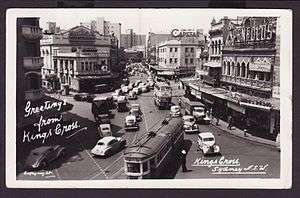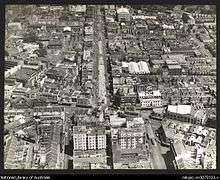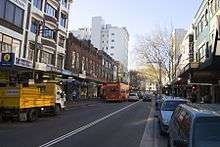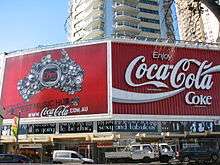Kings Cross, New South Wales
| Kings Cross Sydney, New South Wales | |||||||||||||||
|---|---|---|---|---|---|---|---|---|---|---|---|---|---|---|---|
Darlinghurst_Road-1.jpg) Darlinghurst Road, Kings Cross | |||||||||||||||
| Coordinates | 33°52′25″S 151°13′25″E / 33.87373°S 151.22357°ECoordinates: 33°52′25″S 151°13′25″E / 33.87373°S 151.22357°E | ||||||||||||||
| Population | 20,018 (2001)[1] | ||||||||||||||
| Location | 2 km (1 mi) east of Sydney CBD | ||||||||||||||
| LGA(s) | City of Sydney | ||||||||||||||
| |||||||||||||||
Kings Cross is an inner-city locality of Sydney, New South Wales, Australia. It is located approximately 2 kilometres east of the Sydney central business district, in the local government area of the City of Sydney. It is bounded by the suburbs of Potts Point, Elizabeth Bay, Rushcutters Bay and Darlinghurst.[2]
Colloquially known as The Cross, the area is known as Sydney's red-light district, and is reputed to be home to organised crime groups. Once known for its music halls and grand theatres, it was rapidly transformed after World War II by the influx of troops returning and visiting from the nearby Garden Island naval base. Today, it is a mixed locality offering both services (railway, gyms, supermarket, bakeries) to nearby residents and entertainment venues including bars, restaurants, nightclubs, brothels and strip clubs to visitors.
History


European settlement
The intersection of William Street, Darlinghurst Road and Victoria Street at the locality's southernmost limit was named Queen's Cross to celebrate Queen Victoria's diamond jubilee in 1897. Confusion with Queen's Square in King Street in the city prompted its renaming as Kings Cross, after King Edward VII, in 1905.
During the early 19th century the Darlinghurst area, which extended to include current day Kings Cross, was one of Sydney's most prestigious locations. Being far enough to escape the noise and smell of the central city but close enough for easy travel. An additional attraction was the commanding harbour views to the east and north and (from some points) views to the west as far as the Blue Mountains.
In 1828, the Governor of NSW Sir Ralph Darling subdivided the area, then known as Woolloomooloo Hill, into large allotments which he granted seventeen estates to favoured subordinates and leading businessmen. They built a series of grandiose mansions with sprawling gardens of up to ten acres (4 ha). The remnants of these gardens helped give the area its leafy character, and many of the mansions are commemorated through street names such as Roslyn, Orwell and Kellett. Most of the grand estates were ultimately subdivided with all but a handful of the great houses demolished. One of the surviving homes, located nearby in the suburb of Elizabeth Bay, is Elizabeth Bay House, a quintessential example of Australian colonial architecture. Others, now used for other purposes, include Tusculum in Manning Street and Rockwall.[3] A prominent past resident of this era was David Scott Mitchell.[3]
Bohemian district
The Kings Cross district was Sydney's bohemian heartland from the early decades of the 20th century. The illegal trading of alcohol, known as sly grog, was notorious in the area up until mid-century, led by rival brothel owners, Tilly Devine and Kate Leigh.[3] The area was home to a large number of artists, including writers, poets and journalists including Kenneth Slessor, Christopher Brennan, Hal Porter, George Sprod and Dame Mary Gilmore, entrepreneur Mayfield B. Anthony, actors including Peter Finch and Chips Rafferty, and painter Sir William Dobell.[3]

From the 1960s onwards Kings Cross also came to serve as both the city's main tourist accommodation and entertainment mecca, as well as its red-light district. It thereby achieved a high level of notoriety out of all proportion to its limited geographical extent. Hundreds of American servicemen on R & R (rest and recreation) leave flocked to the area each week in search of entertainment. Organised crime and police corruption was well entrenched in the area – one of Sydney's most notorious illegal casinos operated with impunity for many years, although it was known to all and located only yards from Darlinghurst police station. Much of this activity can be related with Abe Saffron, commonly known as Mr Sin or "the boss of the Cross".
A positive influence in the area during that time was The Wayside Chapel, run by the late Rev Ted Noffs. His church was open most of the time, providing a "drop in centre" and counselling services to many of the itinerants who were drawn to the area. The Ted Noff Foundation, established in 1971,[4] continues his work supporting young people and their families who are experiencing drug and alcohol problems and related trauma.
Juanita Nielsen, a journalist and publisher, campaigned against property development in the Kings Cross area during the 1970s until her sudden disappearance on 4 July 1975. A coronial inquest determined that Nielsen had been murdered, and although the case has never been officially solved, it is widely believed that Nielsen was killed by agents of the developers.[3][5]
As a celebration to commemorate the Stonewall Riots, the inaugural Sydney Gay and Lesbian Mardi Gras pro-gay rights protest march was held on the evening of 24 June 1978. After the protest march, participants were subject to police harassment in Hyde Park, following the revocation of the original protest permit. Some participants headed to Kings Cross where police arrested 53 people, although most of the charges were later dropped.[3] Australia's first widely known transgender person, Carlotta, rose to prominence in Kings Cross whilst working at Les Girls, The Tender Trap, and soap opera Number 96 (TV series).[3]
From the late 1960s, drug-related crime was one of the area's main social problems. In 2001, despite controversy, Australia's first Medically Supervised Injecting Centre was established (where users of illegal drugs can inject themselves at a safe injection site in clean conditions) at a shopfront site in Kings Cross. The injecting room is credited with reducing the occurrence of fatal overdoses in the injecting drug user community, as well as reducing the number of needles left in the street with an interim evaluation report in 2007 claiming[6]
The reduction in opioid-related overdoses was much more substantial in the immediate vicinity of the MSIC than in other neighbouring areas. ... Counts of discarded needles and syringes collected locally indicated a decrease of around 50% following the establishment of the service.

Today
Today with the ongoing operation of tourist accommodation, the proximity to social housing & health care, and the convenient public transport to the city results in a diverse population both resident and passing through at Kings Cross. Since the introduction of controversial lockout laws in March 2014 several nightclubs and pubs in the area have closed down.[7][8]
Landmarks

Darlinghurst_Fire_Station-a.jpg)
- The El Alamein Fountain is at the entrance to the Fitzroy Gardens on the corner of Darlingurst Road and Macleay Street was commissioned as a memorial to soldiers who died in 1942 during World War II in two battles at El Alamein, Egypt. It was designed in 1961 by the New Zealand-born architect Robert Woodward. Its dandelion design, which has since been copied for fountains around the world, was Woodward’s original design.
- The Coca-Cola sign, this has since been turned off and replaced in 2016 with a new sign. Pieces of the original sign were auctioned off on eBay with proceeds going to the Wayside Chapel.
- The Fire Station at the intersection of Darlinghurst Road and Victoria Street was designed by the Government Architect, Walter Liberty Vernon, and built from 1910-12. It is an example of the Federation Free Style and is now listed on the Register of the National Estate.[9]
- Kings Cross railway station is an underground railway station on the Eastern Suburbs & Illawarra Line of the Sydney Trains network.
- The Les Girls building, now known as the Empire Hotel, stood prominently on the corner of Darlinghurst Road and Roslyn Street, in the heart of the Cross. From 1963 until 1993 the building was home to the legendary Les Girls "drag queen" show, starring Carlotta. Throughout the 1990s the building, still retaining its original 1960s features, became the home to alternative cabaret, including the much-loved Sunday nightclub The Tender Trap.
Culture
Events and celebrations
- The Kings Cross Food and Wine Festival is a local annual event held in autumn by the Potts Point Partnership, a business action group.[10][11]
Popular culture
- The television series "Kings Cross ER: St Vincent's Hospital" prominently features medical emergencies that occur in Kings Cross and surrounding areas. The show frequently examines issues in Kings Cross such as violence, homelessness, prostitution, illicit drugs and gang-related incidents. The title was inaccurate as St. Vincent's Hospital is located in Darlinghurst, and it offers an Accident & Emergency department, not an "E.R."
- Kings Cross has made several appearances in popular Australian culture including Paul Kelly's song "From St Kilda to Kings Cross" from the album Post.
- The 1999 Australian crime film Two Hands starring actor Heath Ledger was partly filmed in Kings Cross.
- Clare Werbeloff, became known as the Kings Cross Bogan following her eyewitness account of a shooting outside a Kings Cross nightclub, which turned out to be a hoax. Her politically incorrect report to a television news cameraman spread online via YouTube and made her an internet celebrity.[12]
- The novel The Golden Day by Ursula Dubosarsky is set in a fictitious girls' school in Kings Cross and involves the disappearance of one of the teachers while on a school excursion in 1967.[13]
- The third season of the Australian crime drama series Underbelly is set in Kings Cross. The series is titled Underbelly: The Golden Mile and is a dramatic representation of Kings Cross organised crime. The central figure to the series is an actor portraying the life of John Ibrahim.
- The Australian television series Love Child was set in Kings Cross. It is a fictional drama series based on the lives of teenagers going through underage pregnancy during the 1960s.
Population
In 2001, the area was recognized as the most densely populated in Australia, with 20,018 people living within a 1.4 km2 (0.54 sq mi) area.[1]
External links
- SYDNEY.com - Kings Cross
- Mark Dunn (2011). "Kings Cross". Dictionary of Sydney. Retrieved 27 September 2015. [CC-By-SA]
- Kings Cross Market
Notes and references
- 1 2 Dick, Tim (18 September 2004). "At the crossroads". The Sydney Morning Herald. Fairfax Media. Retrieved 7 March 2007.
- ↑ Gregory's Sydney Street Directory, Gregory's Publishing Company, 2007
- 1 2 3 4 5 6 7 Fitzgerald, Shirley (2007). "The Strip on the strip" (PDF). City of Sydney. Retrieved 14 October 2010.
- ↑ "About". website. Ted Noffs Foundation. Retrieved 24 February 2009.
- ↑ McGuiness, Padraic P (3 March 2004). "Juanita Nielsen, casualty of ideological war". The Sydney Morning Herald. Fairfax Media. Retrieved 14 October 2010.
- ↑ National Centre in HIV Epidemiology and Clinical Research (2007). "Sydney Medically Supervised Injecting Centre Evaluation Report No. 4: Evaluation of service operation and overdose-related events" (PDF). University of New South Wales. Retrieved 23 December 2007.
- ↑ Dumas, Daisy (14 March 2016). "Going, going, gone: 10 iconic bar closures and moves in Sydney". The Sydney Morning Herald. Fairfax Media. Archived from the original on 16 March 2016.
- ↑ Spicer, David (30 July 2015). "Hugo's Lounge in Sydney's Kings Cross forced to close after revenue drop, owner blames lockout laws". ABC News. Australian Broadcasting Corporation. Archived from the original on 10 October 2016.
- ↑ The Heritage of Australia, Macmillan Company, 1981
- ↑ "Kings Cross Festival".
- ↑ "The Potts Point Partnership".
- ↑ Kennedy, Les; Marcus, Caroline (24 May 2009). "Bogus bogan exposed: top cop disarms cult of 'chk chk boom'". The Sydney Morning Herald.
- ↑ Allen & Unwin - Australia. p. 94.
| Wikimedia Commons has media related to Kings Cross, New South Wales. |
